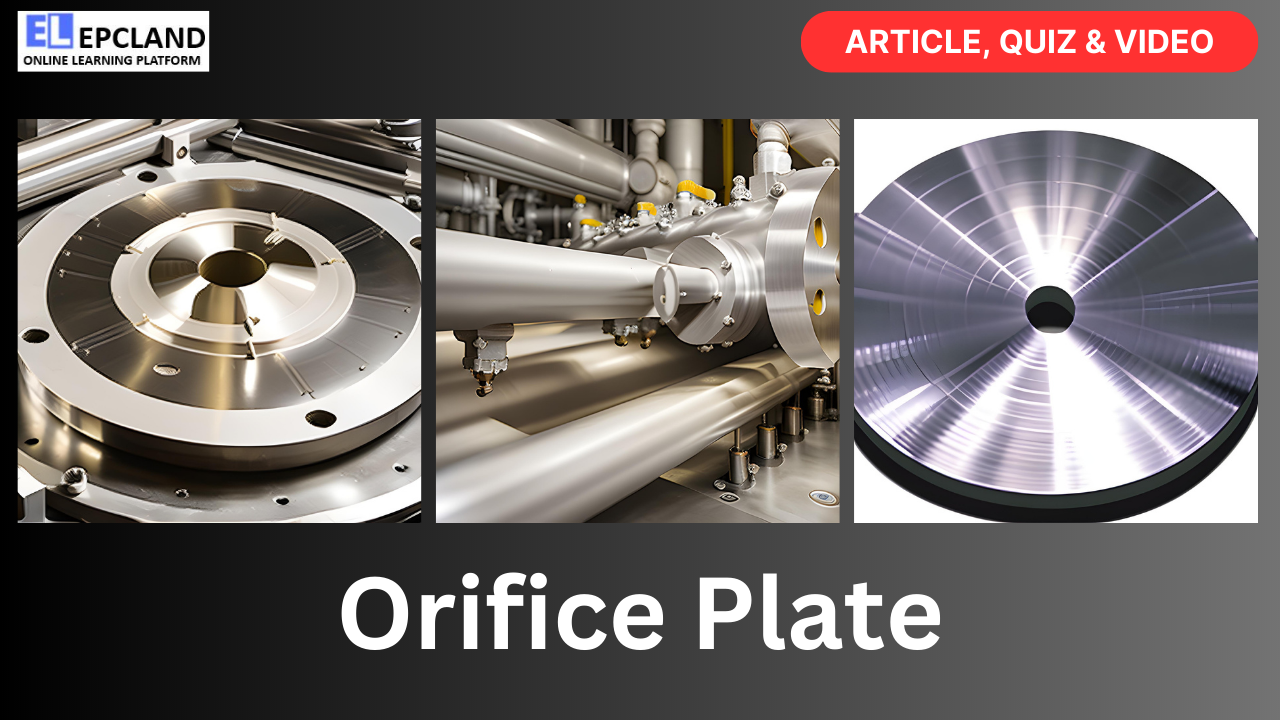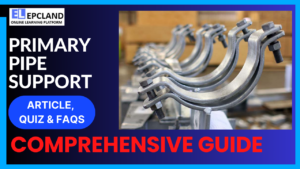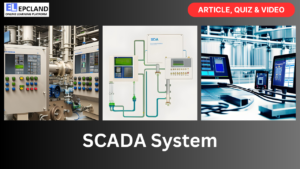The oil and gas industry is a complex and highly regulated sector that relies on precise measurement and control of various parameters to ensure safe and efficient operations. Among the numerous instruments and devices used in this industry, orifice plates hold a crucial position. These simple yet highly effective devices play a vital role in measuring fluid flow rates, pressure differentials, and other critical variables essential for the success of oil and gas projects. In this comprehensive guide, we will explore the importance, principles, types, installation, maintenance, advantages, and disadvantages of orifice plates in the context of oil and gas industry projects.
Table of Contents
Do not miss the Complete Course on Piping Engineering
By EPCLand
Understanding Orifice Plates
Definition and Function
An orifice plate is a thin, flat, and typically circular plate with a hole (or orifice) at its center. It is inserted into a pipeline or flow conduit to create a constriction, causing the fluid to flow through the orifice. The primary function of an orifice plate is to measure the rate of fluid flow, typically of gases or liquids, in the pipeline. By quantifying the pressure drop across the orifice, engineers can calculate the flow rate according to well-established mathematical principles.
Working Principle
The operation of orifice plates is based on the principles of fluid dynamics, particularly Bernoulli’s equation and the continuity equation. When fluid flows through the orifice, it accelerates as it passes through the constriction, leading to a decrease in pressure. The pressure drop across the orifice is directly proportional to the square of the flow rate. This relationship forms the basis for flow measurement using orifice plates.
Importance of Orifice Plates in Oil and Gas Industry Projects
Orifice plates play a critical role in various aspects of oil and gas industry projects. Here are some key areas where their importance is evident:
Flow Measurement and Custody Transfer
Accurate measurement of fluid flow rates is essential for revenue calculation, allocation of resources, and compliance with regulations. Orifice plates provide precise and reliable measurements, making them a preferred choice for custody transfer applications where financial transactions are involved.
Process Control and Optimization
In industrial processes within the oil and gas sector, maintaining control over fluid flow rates is crucial. Orifice plates serve as control elements, enabling engineers to adjust and optimize processes for efficiency and safety.
Safety and Environmental Compliance
Monitoring and controlling fluid flow rates are vital for ensuring safety and environmental compliance. Orifice plates are used in safety systems to detect abnormal flow conditions and trigger emergency shutdowns when necessary, preventing accidents and environmental damage.
Types of Orifice Plates
Orifice plates come in various types, each designed to meet specific measurement requirements and operational conditions. The choice of orifice plate type depends on factors such as the fluid being measured, flow rate, and the desired accuracy of measurement. Some common types include:
1. Concentric Orifice Plates
Concentric orifice plates are the most widely used type in the oil and gas industry. In these plates, the orifice is concentrically located in the center of the plate. They are suitable for measuring clean, single-phase fluids and provide accurate measurements when properly installed.
2. Eccentric Orifice Plates
Eccentric orifice plates have the orifice deliberately offset from the center of the plate. This design is often used for measuring fluids with entrained solids or high viscosity, as it helps prevent clogging of the orifice.
3. Segmental Orifice Plates
Segmental orifice plates have a portion of the plate removed, leaving a segment of a circle as the orifice. They are employed in applications where it is necessary to handle high flow rates while minimizing pressure drop. Segmental plates can also be used for measuring non-circular pipe flows.
4. Quadrant Orifice Plates
Quadrant orifice plates are used for measuring flows that contain suspended solids, fibers, or pulp. They feature a circular hole with four quadrant segments removed. This design prevents blockages and provides accurate measurements in challenging fluid conditions.
5. Plate Materials
Orifice plates can be made from various materials, including stainless steel, carbon steel, and other alloys, depending on the specific requirements of the application. The choice of material should consider factors such as corrosion resistance and process fluid compatibility.
Installation and Maintenance of Orifice Plates
The accurate functioning of orifice plates depends not only on their design but also on proper installation and regular maintenance. Here are key considerations for both:
Installation
1. Positioning
Position the orifice plate carefully within the pipeline to ensure accurate measurements. It should be installed with the orifice bore perpendicular to the direction of flow.
2. Upstream and Downstream Piping
Proper lengths of straight pipe are required both upstream and downstream of the orifice plate to ensure flow stabilization. These lengths, known as “pipe runs,” help eliminate turbulence and disturbances that can affect measurement accuracy.
3. Tappings
Install pressure tappings upstream and downstream of the orifice plate. These tappings allow for pressure measurement, which is crucial for calculating flow rates. Ensure that the tappings are correctly aligned and sized according to industry standards.
4. Gaskets and Seals
Use appropriate gaskets and seals to prevent leakage around the orifice plate. Leakage can result in inaccuracies in flow measurement.
Maintenance
1. Inspection
Regularly inspect the orifice plate and associated components for signs of wear, corrosion, or damage. Replace any damaged parts promptly to maintain accuracy.
2. Cleaning
In applications where the fluid may contain contaminants, such as solids or debris, schedule regular cleaning to prevent blockages in the orifice.
3. Recalibration
Periodic recalibration of the orifice plate and the associated instrumentation is essential to ensure accurate measurements over time. Calibration should be performed by qualified personnel using traceable standards.
Advantages and Disadvantages of Orifice Plates
Here is a table summarizing the advantages and disadvantages of using orifice plates in the oil and gas industry:
Do not miss the Complete Course on Piping Engineering
By EPCLand
| Advantages | Disadvantages |
|---|---|
| Simple and cost-effective | Pressure recovery is lower than some other flow measurement devices |
| Highly accurate under the right conditions | Prone to wear and damage over time |
| Suitable for a wide range of fluid types and flow rates | Requires careful installation and maintenance |
| Well-established technology with industry standards | May not be ideal for applications with rapidly changing flow rates |
| Compatible with various plate materials for different applications | Inaccurate measurements if not properly sized and installed |
| Effective for custody transfer applications |
Orifice Plates in Oil and Gas Industry Applications
Orifice plates find widespread use in various oil and gas industry applications, including:
1. Wellhead Measurement
In upstream operations, orifice plates are often installed at wellheads to measure the flow rate of oil and gas as it is extracted from the reservoir. This data is critical for production optimization and allocation.
2. Pipeline Monitoring and Custody Transfer
Orifice plates are used in pipelines to monitor the flow of hydrocarbons. They facilitate custody transfer between different entities and ensure accurate billing based on the transported volume.
3. Refining and Petrochemical Processes
Refineries and petrochemical plants use orifice plates to measure and control the flow of feedstock, chemicals, and products throughout the manufacturing process. Accurate flow measurement is essential for product quality and safety.
4. Safety Systems
Orifice plates are integrated into safety systems to detect abnormal flow conditions, such as leaks or ruptures in pipelines. When such conditions are detected, safety shutdown systems can be activated to prevent accidents.
5. Environmental Compliance
Ensuring compliance with environmental regulations is a top priority in the oil and gas industry. Orifice plates play a role in measuring emissions and ensuring that facilities operate within permitted limits.
Challenges and Future Trends
While orifice plates have been a reliable choice for flow measurement in the oil and gas industry, several challenges and future trends are worth noting:
1. Accuracy and Calibration
Achieving high levels of accuracy in flow measurement can be challenging, especially in applications with varying operating conditions. Calibration and maintenance are crucial to maintaining measurement precision.
2. Non-Intrusive Measurement
Advancements in technology are leading to the development of non-intrusive flow measurement techniques, which may reduce the reliance on traditional orifice plates in some applications.
3. Digitalization and Automation
The industry is embracing digitalization and automation to enhance measurement, control, and data analysis. This includes the use of smart sensors and remote monitoring solutions.
4. Environmental Monitoring
With increasing focus on environmental sustainability, there is a growing need for accurate measurement of emissions and environmental parameters. Orifice plates may play a role in such monitoring systems.
Conclusion
Orifice plates are unsung heroes in the oil and gas industry, quietly ensuring accurate flow measurement and contributing to safety, efficiency, and compliance. Their simple yet effective design, based on fundamental principles of fluid dynamics, makes them invaluable in a wide range of applications, from wellhead measurement to refinery processes and safety systems. Proper installation, maintenance, and calibration are essential to maximize their effectiveness.
As the industry continues to evolve, orifice plates will remain a vital component in the pursuit of efficient and sustainable operations. Advancements in technology, digitalization, and automation will shape the future of flow measurement in the oil and gas sector, but the fundamental principles that underlie the orifice plate’s function will continue to guide its application and importance.
In conclusion, the oil and gas industry owes a debt of gratitude to these unassuming devices that quietly measure the flow of hydrocarbons and help keep operations running smoothly and safely.
Do not miss the Complete Course on Piping Engineering
By EPCLand
FAQs
- What is the purpose of using an orifice plate in the oil and gas industry?Orifice plates are used in the oil and gas industry primarily for measuring the flow rate of fluids, such as oil, gas, or liquids, within pipelines and process systems. They provide accurate flow measurements, which are essential for custody transfer, process control, and safety monitoring.
- How does an orifice plate work in flow measurement?An orifice plate works based on the principles of fluid dynamics. When fluid flows through the orifice, it accelerates as it passes through the constriction, leading to a decrease in pressure. The pressure drop across the orifice is directly proportional to the square of the flow rate. This pressure drop is then used to calculate the flow rate accurately.
- What are the advantages of using orifice plates in the oil and gas industry?Some advantages of using orifice plates include their simplicity, cost-effectiveness, accuracy under the right conditions, suitability for a wide range of fluid types and flow rates, compatibility with various materials, and their effectiveness for custody transfer applications.
- What are the main challenges associated with orifice plates in flow measurement?One of the primary challenges is ensuring accuracy under varying operating conditions, which may require regular calibration. Orifice plates are also prone to wear and damage over time, and proper installation and maintenance are essential. Additionally, they may not be ideal for applications with rapidly changing flow rates.
- Are there alternatives to orifice plates for flow measurement in the oil and gas industry?Yes, there are alternative flow measurement devices, including venturi tubes, magnetic flow meters, and ultrasonic flow meters. These devices have specific advantages and disadvantages and may be chosen based on the specific requirements of the application.
Recommended courses (Published on EPCLand)
- Basics of Piping Engineering
- Piping Layout Engineering
- Piping Material Engineering
- Piping Stress Analysis
- Complete Course on Piping Engineering
- Material Requisitions
- Piping Material Specifications
- Valve Material Specifications
Don’t miss the published articles on following:
| Industrial Applications with Link | Industrial Applications with Link |
| Corrosion Monitoring Instruments | Safety Instrumented Systems |
| Instrumentation in Renewable Energy | Safety Relief Valves |
| Orifice Plate in the Oil & Gas Industry | Well Test Instruments |
| Wellhead Pressure and Temperature Gauges | Wireless Instrumentation in Oil & Gas Projects |
Related Video
Attempt Quiz
Question 1:
What does “PID” stand for in the context of control systems used in oil & gas projects?
Explanation: In the context of control systems used in oil & gas projects, “PID” stands for Proportional-Integral-Derivative, which is a type of control algorithm.
Question 2:
What is the primary purpose of a Proportional component in a PID controller?
Explanation: The primary purpose of the Proportional component in a PID controller is to reduce steady-state error by adjusting the control output in proportion to the error signal.
Question 3:
Which component of a PID controller is responsible for eliminating long-term errors?
Explanation: The Integral component of a PID controller is responsible for eliminating long-term errors by continuously summing the error signal over time and adjusting the control output accordingly.
Question 4:
What is the role of the Derivative component in a PID controller?
Explanation: The role of the Derivative component in a PID controller is to reduce sudden changes in the control output by providing a control action based on the rate of change of the error signal.
Question 5:
In oil & gas applications, where might you commonly find PID controllers used?
Explanation: In oil & gas applications, PID controllers are commonly used for industrial control of temperature, pressure, and flow in processes such as refining, pipeline control, and petrochemical manufacturing.



